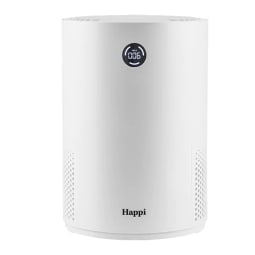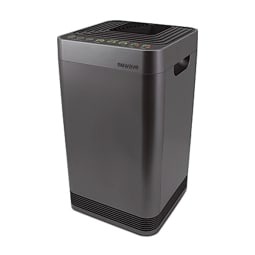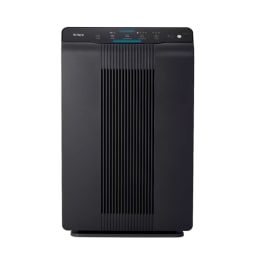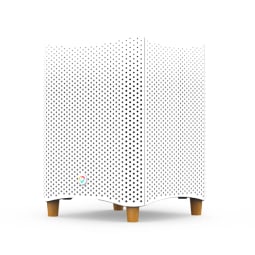Advertisement
The 7 Best Air Purifiers For Dust Of 2023

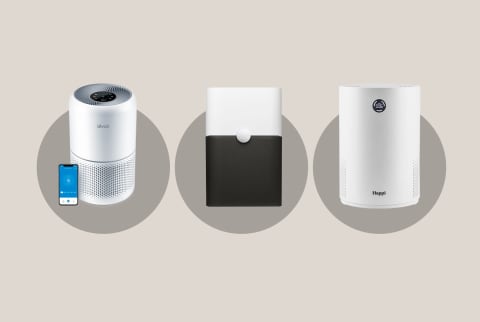
We'll be honest, dusting can be one of the most futile household chores. After a solid swipe session with a cloth or spray, it often only takes a few days before that pesky dust finds its way right back to your surfaces—which is especially frustrating and disruptive if you're allergic to these particles.
The best air purifiers help to remove allergens and pollutants so that they're not circulating through our indoor spaces and sneaking their way into our bodies.
After all, research shows that dust and other indoor air pollutants can be harmful to our respiratory health1. It can also exacerbate symptoms of sneezing and wheezing, as well as conditions like asthma.
Adding the an air purifier to your space is a great way to eliminate this pesky health concern—and we've already spoken with experts to help you find the best air purifier to bust some dust.
The best air purifiers
- Best rated for dust: Levoit Core 300S
- Best affordable: My Happi
- Best for mold & dust: Blueair Blue Pure 211+
- Best for large rooms: NuWave OxyPure Smart Air Purifier
- Best with washable filters: Winix 5500-2
- Best looking air purifier: Mila
- Best for dust & smoke: Honeywell Allergen Plus HPA200
What is an air purifier?
An air purifier is a nifty device that works tirelessly to clean the air you breathe, kicking dust, pollen, pet dander, and even pesky pollutants to the curb.
It employs a combination of filters and sometimes other technologies such as UV-C or ionization to capture or neutralize particles like dust, pollen, pet dander, smoke, and even bacteria and viruses.
How do air purifiers work?
"Air purifiers cleanse the air by pulling it into the unit's system using an internal fan and an interconnected series of filters," explains Michael Rubino, a mold and air quality expert and author of The Mold Medic, an Expert's Guide on Mold Removal. "The filters then capture small particles such as dust (as well as other indoor contaminants, depending on the air purifier) and recirculate the cleansed air back into the indoor space."
Purifiers use a range of filter materials, including HEPA (high-efficiency particulate air), activated carbon, media, spun glass, and pleated filters. "Some machines also use a combination of these materials to cleanse the air further," Rubino adds.
When it comes to filters, Rubino and allergist Anjuli Mehrotra, M.D., agree that HEPA is the gold standard, especially as it's the only filter certified to meet the U.S. Department of Energy's standards2.
"For allergies, we recommend HEPA filters, as they are able to filter out allergens that are less than 10 microns in size, which include airborne dust particles; pollen from trees, grasses, and weeds; as well as pet dander and mold spores," Mehrotra advises.
How to choose the best air purifier
There are a few key factors to consider when shopping for an air purifier for removing dust.
Filter quality
Rubino and Mehrotra both note that the quality of a purifier depends on the quality of the filter. "A solid air purifier should at least meet HEPA status, meaning that it removes 99.97% of particles as small as 0.3 micron," says Rubino.
For reference, a micron is a unit of measurement equal to one-millionth of a meter. Here's how the most common particle pollutants stack up:
- Dust: 0.3 - 10 microns
- Mold: 4 - 10 microns
- Pollen: 30 microns
- Pet dander: 0.5 - 100 microns
- VOCs: Often 6 microns or less
- Smoke: 0.1 to 1 micron
In addition to HEPA, you'll also see activated charcoal or carbon filters on our list. Carbon is effective at removing smoke particles, gases, and odors from the air—just note that, while these purifiers may pack an extra punch, they'll likely come with a higher price tag.
Cost of filter replacements
Because purifiers require a filter change every three to 12 months (the time frame varies by brand and how often you run your device), you'll want to consider the cost of new filters on top of the machine's cost.
Each brand has its own type of HEPA filter, and they all come at different prices—some brands even offer a subscription discount for scheduled refills.
Room size
"It's important to consider the size of the room when choosing a purifier," says Mehrotra. "The filtration process can vary from product to product, but the goal of air purification is about five or six air changes per hour in the room, a rate that is sufficient to decrease particle levels in the room by about 70%."
One way to gauge the effectiveness of a purifier is the product's CADR, or Clean Air Delivery Rate—a measurement developed by the Association of Home Appliance Manufacturers (AHAM) in the 1980s. "CADR measures the amount of particle-free air being delivered into the room," explains Mehrotra. "It reflects both how effective the filter is and the amount of air going through the filter. The higher the clean air delivery rate, the larger the size room that can be properly cleaned."
Mehrotra adds that a good CADR rating is equal to at least two-thirds of the room's area in square feet. For example, a room that measures 10 feet by 15 feet has an area of 150 square feet. For this room, a good CADR rating would be at least 100 cubic feet per minute (cfm).
How we picked the best air purifiers
- Expert input: Per expert guidelines, we only included purifiers that use HEPA filters. A few even have carbon or activated charcoal to tackle VOCs and gases.
- Reviews & certifications: We read hundreds of reviews for each of these purifiers to learn what a range of customers loved (and didn't love) about them. We also considered energy ratings and will call out brands that are Energy Star Certified.
- Price: Air purifiers come at a wide range of price points and, while design and features vary, there's a reliable pick on our list for any budget.
- Size variety: We'll list the manufacturer's provided CADR and suggested room size for optimal use, although each product can certainly help with larger or smaller spaces as well.
Our top picks for the best air purifiers of 2023
Pros:
- Over 75,000 ratings on Amazon
- Affordable replacement filters
- Sleek design
Cons:
- Best for smaller rooms
- May not hold up as long as more expensive models
Type:
HEPA filterPre-filterCarbon filterCoverage area:
Best for 547 square feet (CADR = 140 cfm)When to replace filters:
Every 6 to 8 monthsWarranty:
2-yearThis Energy Star–certified air purifier uses a three-stage filtration system that takes air through a prefilter for larger gunk, a HEPA filter for particles, and an activated charcoal filter for odors and gases. The second is key to removing dust from the air, ultimately helping to keep up to 547 square feet smelling fresh. The budget-friendly device also has a timer option for regular air cleanings and a sleep mode that quiets operation and dims lights. Plus, it's budget-friendly, at least less than $200–and even refills are relatively inexpensive at $30 (with changes required every six to eight months).
What customers say:
This air purifier has over 60,000 five-star ratings on Amazon and gets rave reviews from people with dust allergies, pets, and smoke sensitivities. According to one reviewer, "You can feel and breathe the difference in the air after a few hours of running it. I live in a very tiny apartment with a cat and lots of upholstery and surfaces that hold dust and dander. I have noticed an extreme difference in air quality even after about two months now." Some negative comments speak to the durability of this purifier, with several folks saying it got louder over time.
Pros:
- Quiet
- The brand plants a tree for every filter sold
Cons:
- Not as many reviews
- Change filter alert makes a beep sound
Type:
HEPA filterPre-filterActivated carbon filterCoverage area:
Best for up to 500 square feet (no CADR rating)When to replace filters:
6-10 monthsWarranty:
1-yearA budget-friendly pick, the My Happi purifier is a great small-space option. It uses a vacuumable pre-filter, a carbon filter for odors, and a HEPA filter for pollen, dust, and pet dander. It has three super-quiet fan speeds, and there's also a small LED display that tells you the air quality status in real time. Happi doesn't offer a CADR rating for this purifier, but they claim you can run it in spaces up to 500 square feet.
What customers say:
There aren't a ton of reviews of this purifier, but most of the reviews that do exist are positive. One reviewer writes, "My Happi works to make certain that lingering odors or dust are always under control! This air cleaner really and truly is very quiet, which in my book makes it a winner! I think this is a perfect choice for smaller rooms; utility, laundry, extra bedroom or office." On the con side, some people say the "change filter" notification goes off earlier than six months and makes an annoying beep sound.
Advertisement
Pros:
- Washable, fabric pre-filter
- Energy efficient
Cons:
- No timer or air quality display
Type:
HEPA filterWashable pre-filterCarbon filterCoverage area:
Best for 540 square feet (CADR = 350 cfm for dust)When to replace filters:
Every 6 monthsWarranty:
2-yearWhile an air purifier can't actually eliminate stagnant mold (you'll need to tackle mold separately), it can remove mold spores from the air and help make a once-moldy space smell fresh again. The Blueair Blue Pure 211+ is a solid, Energy Star–rated purifier that aims to do just that. Its washable fabric pre-filter, which comes in a handful of color options, is the first line of defense, followed by the main HEPA filter that grabs smaller particles like mold spores, dust, and pollen. Finally, there's a layer of activated carbon that focuses on odors and VOCs. This quiet filter does the job but doesn't come with a lot of bells or whistles. There's only one button that lets you switch between three speeds and an LED light that tells you when it's time to change your filter.
What customers say:
This filter gets great reviews from customers—82% of the 11,000 ratings give it five out of five stars. "I was having great difficulty breathing after a then-unknown mold exposure. Between the time the mold was discovered and the time it took to get a contractor out to take care of it, I could not breathe indoors. This purifier allowed me to breathe almost immediately." Some negative reviews from people say they wish the 211+ had a timer, and some people complain that it's expensive for the lack of features.
Pros:
- On wheels & effective for larger spaces
- Six fan speeds & auto mode
- Longer filter lifespan
Cons:
- Larger size
Type:
HEPA filterCarbon filterWashable ozone removal filterWashable stainless steel pre-filterCoverage area:
Best for 515-1,200 square feet (CADR = 351 cfm for dust)When to replace filters:
Every 12 monthsWarranty:
5-yearHence the "Smart" in the name, you can control this purifier from OxyPure with an app. It has six fan speeds, several timer options, and a display to show the air quality status in the room. In Auto mode, it measures the air quality in the room and adjusts settings—you guessed it—automatically. With a high CADR rating and five-stage filtration, this pick is great for larger rooms. In fact, while the baseline coverage is 515 square feet; several reviews comment on it being really effective in rooms up to 1,200 square feet. It also comes on wheels so you can move it around your space.
What customers say:
There are a ton of rave reviews for this purifier, including this Amazon shopper: "The air quality has changed so much in my home. The unit is large enough to purify the air throughout the entire home. My home is three stories and you can tell the difference on each floor." On the con side, it's a bigger unit (14 by 14 by 26 inches) and not the most aesthetically pleasing design. But while some people find this device expensive, others say the higher price tag is worth it for the coverage and the fact that the filters are designed to last longer.
Advertisement
Pros:
- Washable pre-filter & carbon filter
- Sleep mode responds to darkness & light
Cons:
- Harsh design
- Bright display lights that don't turn off
Type:
HEPA filterIonizerWashable pre-filterWashable carbon filterCoverage area:
Best for 360 square feet (no CADR rating)When to replace filters:
Every 12 monthsWarranty:
2-yearThis option sounds (and looks) like something out of a Star Wars movie. Whether that's a good or a bad thing for you, the Winix 5500-2 is a great, effective pick that boasts both a washable pre-filter and carbon filter in addition to the HEPA filter. It also features a timer, four fan speed settings, and an optional ionize, which the brand calls PlasmaWave.
Coolest of all, this Energy Star–certified pick automatically activates "Sleep Mode" when the room is darkened for a quieter run and changes back to "Auto Mode" when it senses light. In terms of upkeep, Winix recommends washing the pre-filter every two weeks and the carbon filter every three months. You'll also need to get a new carbon and HEPA filter every 12 months.
What customers say:
This pick from Winix gets rave reviews on Amazon, where it has 23,000 ratings and 4.7 out of 5 stars. People rave about the longevity of this device thanks to the washable filters. A longtime user says, "5 years of literal constant use. I have absolute confidence stating that this is a solid piece of machinery." Less glowing reviews mention the bright lights on this device, and some people complain about the cost involved to replace the carbon filter in addition to the HEPA filter.
Pros:
- Great design & interactive app
- Customizable filter subscription
Cons:
- App connectivity can be an issue
Type:
Various HEPA filter typesCoverage area:
Best for 363 square feet (CADR = 146 cfm for dust)When to replace filters:
Every 6 months (subscription available)Warranty:
1-yearFor something a little more design-friendly, check out Mila. This high-tech but aesthetically pleasing device is a super-customizable pick. Complete with an app that gives you live status updates on your air quality, Mila works with Amazon Alexa and Google voice assistants, has a "Quiet Mode" that senses when you're in the room, and even warns you about poor air quality outdoors.
Mila can also act as a carbon monoxide detector and monitors the humidity level in your room to alert you about possible mold growth.
What customers say:
Mila is relatively new to the purifier market, and the only reviews on the Mila website are glowing. Amazon has a few reviews, most of which are positive with regards to the features and design. "There are so many functions to choose from. Mila even has a sense of humor! The app works perfectly and gives us great updates," a satisfied reviewer writes. Some folks experienced issues with app connectivity, and a couple of people say it isn't the most powerful purifier they've owned.
Advertisement
Best for dust & smoke: Honeywell Allergen Plus HPA200
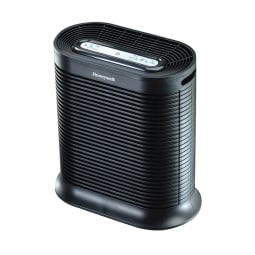
Pros:
- Three size options
- Highly rated for dust and smoke removal
Cons:
- Loud
Type:
HEPA filterPre-filterCoverage area:
310 square feet (CADR = 190 cfm for dust)When to replace filters:
HEPA filter every 12 monthsPre-filter every 3 monthsWarranty:
5-yearWhile it's not super design-friendly, the models under Honeywell's Allergen Plus series are popular purifiers for tackling dust and smoke. This is the HPA200, which is rated to 310 square feet, but Honeywell sells a smaller and larger model of this purifier as well. With solid features like a timer, four fan speeds, and the ability to dim or turn off the display lights, it has just the right amount of frills.
The pre-filter captures large particles such as dust and pet fur and includes carbon to reduce VOCs & odors from smoke and cooking—the HEPA filter picks up the rest.
What customers say:
Honeywell's Allergen Plus series gets great feedback on Amazon, with 4.7 out of 5 stars across over 29,000 ratings. This reviewer raves, "We have a lot of problems with hazardous smoke this time of year. The HPA300 works great. We have one positioned in our hallway so the purifier is blowing up to the ceiling right where our central HVAC intake is. We also have an HPA200 unit that we move around to whichever room we are in."
One downside, though, is that Honeywell suggests you replace the pre-filter every three months. Some reviewers also say it's rather loud compared to other purifiers.
Comparing the best air purifiers
| Product | Price | Type | Room capacity | Filter replacement frequency | Warranty |
|---|---|---|---|---|---|
| Levoit Core 300S | $150 | HEPA filter/Pre-filter/Carbon filter | 547 square feet | Every 6-8 months | 2-year |
| My Happi | $99 | HEPA filter/Pre-filter/Activated carbon filter | 500 square feet | Every 6-10 months | 1-year |
| Blueair Blue Pure 211+ | $320 | HEPA filter/Washable pre-filter/Carbon filter | 540 square feet | Every 6 months | 2-year |
| NuWave OxyPure Smart Air Purifier | $600 | HEPA filter/Carbon filter/Washable ozone removal filter/Washable stainless steel pre-filter | 515-1200 square feet | Every 12 months | 5-year |
| Winix 5500-2 | $250 | HEPA filter/Ionizer/Washable pre-filter/Washable carbon filter | 360 square feet | Every 12 months | 2-year |
| Mila Air Purifier | $350 | Various HEPA filter types | 363 square feet | Every 6 months (subscription available) | 1-year |
| Honeywell Allergen Plus HPA200 | $178 | HEPA filter/Pre-filter | 310 square feet | HEPA filter every 12 months/Pre-filter every 3 months | 5-year |
Do air purifiers capture dust?
While quality air purifiers are effective for removing dust in the air, don't expect to completely eliminate the dust (or other undesirable particles in your home) with the push of a button.
"Not all allergens are airborne, and air filters may not work as well for these. Dust mites (microscopic insects that live in dust and are responsible for most dust allergies) or other allergens that have settled into the ground, carpet, or furnishings," explains Mehrotra.
In other words, a purifier isn't a replacement for a vacuum. Your best bet for truly combating dust (and dust mites) is combining an air purifier with an effective cleaning routine—and paying close attention to your rugs, carpet, and furniture.
How to care for an air purifier
Do air purifiers need to be cleaned?
Yes. Pre-filters can benefit from a wash or a vacuum every month or so, and you'll need to replace the HEPA filter (and possibly other filters, depending on the design) to keep your device running smoothly and effectively.
How often should you clean an air purifier?
Each product is different, and the lifespan of a filter can last anywhere between three and 12 months. To get the most out of your filter, it's best to adhere to the manufacturer's suggested filter replacement times.
Should I leave my air purifier on all the time?
How often you run your air purifier will depend on your home's air quality and your personal preferences. If you have allergies or live in a city with poor air quality, you may run your purifier more often. Focusing on an energy-efficient model will help keep electric costs low.
Frequently asked questions
How do air purifiers and HEPA filters work?
"Air purifiers work by taking in air at a certain rate, 'purifying' the air, then recirculating the air back into the room," explains Mehrotra. HEPA filters, the gold standard for air purifiers, use intricately woven layers of plastic or glass fibers to catch and trap particles as small as 0.3 micron (although they can catch some smaller particles, too).
Where is the best place to put an air purifier?
You'll get the most out of an air purifier by putting it in the room (or rooms) you spend the most time in. "Away from clutter and in a high-airflow space is best so that they can actively work to cleanse the air," suggests Rubino. Living rooms, bedrooms, and kitchens are great options.
Are air purifiers worth it?
"Air purifiers, especially ones with built-in HEPA filters, can be beneficial for people with allergies or asthma, as well as people with underlying lung diseases who may be sensitive to smoke, air pollutants, and other airborne particles," explains Mehrotra. There are plenty of quality, budget-friendly options—just remember, air purifiers are not a replacement for regular household cleaning.
The takeaway
"On average, we breathe 20,000 breaths per day and spend 90% of our time indoors, so what's in our air matters," says Rubino. Air purifiers remove dust, mold, and other allergens and filter out certain airborne viruses and bacteria, which can be helpful at preventing illness.
Choosing a purifier that uses a HEPA filter is an important first step—then weigh the other features and air turnover capacity to find the right pick for your home. And since allergies are year-round, you may want to consider these best air purifiers for allergies, too.

